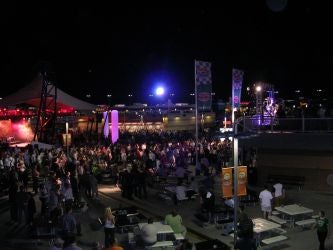 |
LIVE From VMworld |
The exhibitors have packed up, the attendees have returned home; VMworld 2008 has come to a close. But is the party really over?
VMware’s strategy may be sound, but its ultimate success will be reliant on forces beyond its control.
VMware laid out some very grand plans this week. Its partners and competitors were equally vocal.
In the days leading up to the show, the question was, would VMware override the turmoil and lack of direction that seemed to envelop it as of late? Although VMware was preaching to choir, from an attendee perspective, the vendor did indeed seem to deliver, and the question didn’t surface in the buzz.
Instead, the economy remained the elephant at the show. Whether it was casual hallway conversation or presentations, Wall Street loomed larger than Silicon Valley on everyone’s mind. VMware spared no expense at the show, from the Wednesday night party at the Las Vegas Speedway to amenities throughout the show, and it seemed both incongruous and surreal. More than one attendee commented that it felt very much a it was a last hurrah.
VMware’s vision aside, the two things that left the biggest impression were the international nature of the show and the focus on the desktop.
Attendees from as far away Europe and Asia-Pacific were present. The press room was abuzz with media outlets from all over the world. For now, the vendor community appears to be U.S.-centric, but virtualization has gained worldwide acceptance. Based on the geographic demographics present it certainly makes sense that VMware is holding its second annual European show in Cannes, France, in February.
 |
| VMware’s party at the Las Vegas Speedway |
Even more interesting was the focus on the desktop, or rather, the “client.” Mobile devices may well be what ultimately drives acceptance of virtualization into the user side of the enterprise. In fact, client-side virtualization seemed to occupy the “hottest angle” role that storage previously held, perhaps because virtual storage has gained mainstream acceptance, and client-side virtualization will actually impact storage.
As interesting as client-side virtualization is, however, not everyone was convinced of its viability. Richard Clifton, senior vice president and general manager, virtualization and grid infrastructure BU at NetApp, told ServerWatch that he believes “Application virtualization enablement” is the next big thing because there is a “strong correlation between that and the desktop.” Currently, the economics of desktop enablement simply aren’t there.
“You have to put too much into the infrastructure and frequently are not getting rid of clients or back-end costs,” he explained. “It’s easy to justify server virtualization — save now, save later — whereas the desktop is is spend now, save later.
Reading Between the Lines, The Importance of the Less-Tangible
It would also be a mistake to discount the atmosphere surrounding the show. Sometimes the superficial really isn’t. For example, at a vendor-sponsored show you can tell a lot about a vendor from its press room. Comparatively speaking, VMworld offered fairly opulent working conditions. At some shows the press room is no bigger than a closet tucked away in a back corner, far away from the action. Clearly an afterthought. Others provide connectivity but no food.
 More VMworld Coverage
» The Big Picture on VMware’s Big Change» Party Like It’s 1999 » VMware CEO Maritz Charts Virtualization’s Future |
The press and analyst workroom at VMworld, like everything else about the show, was first class. There was no food here; that was found in a well-stocked lounge down the hall, which had cocktail tables and comfortable couches. There was even security in the corridor to keep out anyone who did not have the right color badge. There was also a press and analyst party at the midpoint of the show.
But what the journalists and analysts seemed to appreciate the most was something so simple, and yet so many trade shows are missing it: an ample supply of Ethernet cables (wireless connectivity was spotty at best) and power strips as well as several printers at the ready. Such a small thing, and yet it demonstrated an understanding of what is needed for people to get their jobs done.
If this is indicator of VMware’s ability to execute it will indeed fulfill the technological side of its roadmap. Selling the all-encompassing vision to enterprises will be a much tougher endeavor. As enterprises become increasingly cost-conscious, selling a solution that in effect replaces one that is already “good enough” will be a challenge.
Hyper-V is currently free, which no doubt will appeal, especially to SMBs. Even if the available management tools are not included, if a viable ecosystem builds up around Hyper-V, it is a route many enterprises will likely consider.
The outcome of virtual battle remains to be seen. A lot can (and will) happen between now and 2009, when VMware eventually delivers on its ambitious vision.
Amy Newman is the managing editor of ServerWatch. She has been following the virtualization space since 2001.

